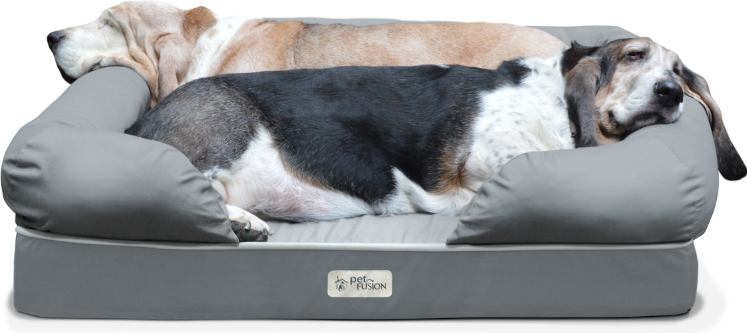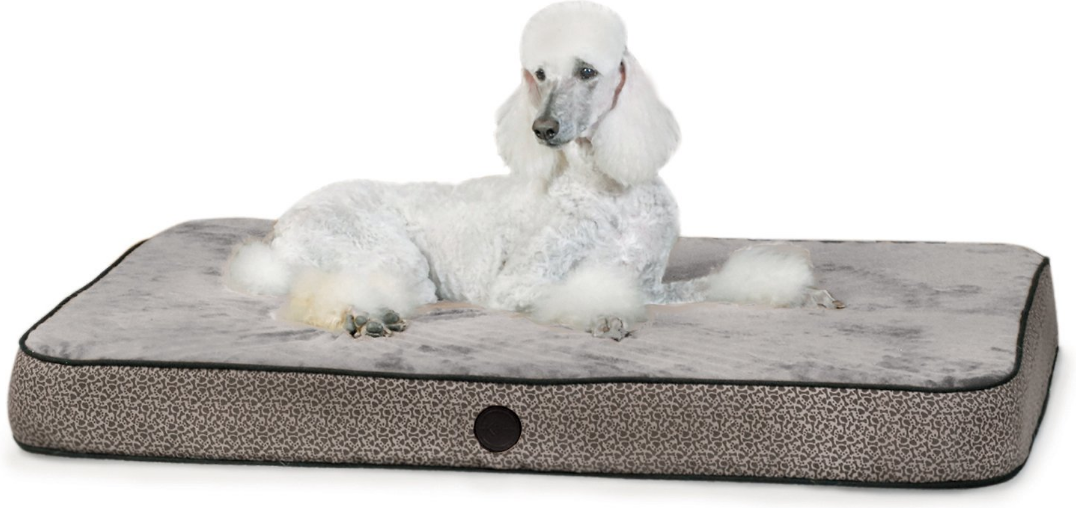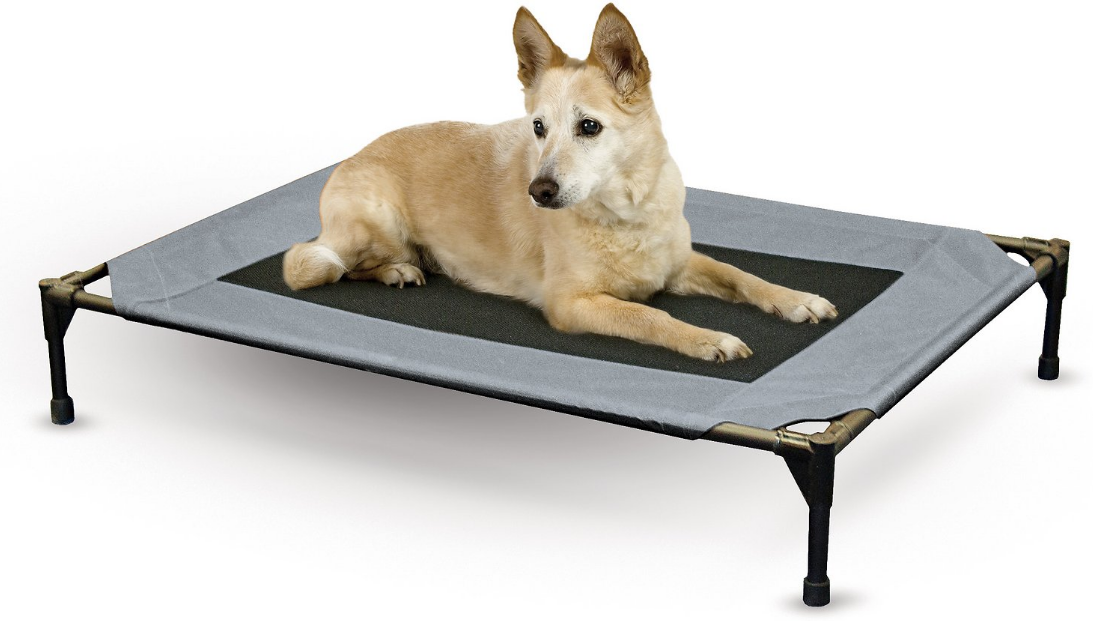The Ultimate Guide To Buying a Dog Bed
Quick Guide
How To Pick The Perfect Dog Bed
Many dog owners find that when they purchase an expensive bed for their dog that he still prefers to sleep on the floor or, even worse, on your furniture. If your dog does this, it may lead you to wonder whether a dog bed is really necessary for your dog. After all, if he doesn’t use it, what good is it? Even if your dog doesn’t like his dog bed at first, however, it is still a good idea to provide one. In this article you will learn the basics about why dogs need dog beds and you will receive an overview of the most popular types of dog beds including pros and cons for each.
Why Does Your Dog Need a Bed?
While many dogs can and will sleep anywhere, that doesn’t mean that they should. In the same way that you crave a soft, comfortable place to rest your head at night, so does your dog deserve a space of his own. A dog bed doesn’t just provide your dog with a comfy place to lie down, but it can actually help to regulate his temperature and cushion his joints. In the winter, a dog bed will help to insulate your dog and protect him from the cold floor while, in the summer, certain types of beds can help to keep your dog cool. As an added bonus, many dogs receive a sense of security and safety from their beds, viewing them as a private and personal space that is entirely their own.
Another practical benefit that dog beds have to offer is the cushioning of your dog’s bones and joints. This is particularly important for older dogs and for dogs that suffer from musculoskeletal issues or arthritis. Sleeping on the cold, hard ground can wreak havoc on your dog’s bones and joints while an orthopedic dog bed can provide the support he needs to reduce pain and to improve comfort. If your dog suffers from bone and joint problems, giving him a bed of his own will keep him from jumping up and down from your furniture, thus reducing his risk for injury. Support is also very important for large-breed dogs because they have a higher risk for developing arthritis and other musculoskeletal issues as they get older.
Aside from the practical benefits that dog beds provide for dogs, they are also very beneficial for you as the dog owner. If you are tired of vacuuming dog hair off of your upholstered furniture, providing your dog with a bed of his own can help to control the spread of shed hair and dander to one easy-to-clean location. Many dog beds feature removable covers which can be thrown into the washing machine. If your dog happens to develop a flea infestation, you will be glad to keep most of the fleas concentrated in his bed, an easy to clean surface, while minimizing the spread of fleas to your furniture and other household surfaces that are more difficult to clean.
What’s In a Dog Bed?
In addition to considering the type of dog bed you want for your dog, you also have to think about the filling. There are three main types of filling for dog beds and each option offers its own unique set of benefits.
Polyfil
Polyfil is a type of high-loft fiber made from recycled soda bottles and it is a type of material that you can fluff again and again – it doesn’t go flat.
Baffled Polyfil
Baffled polyfil is usually used to fill interlocking tubes which provide uniform support and comfort without bunching.
Foam
Foam, especially orthopedic foam, offers the most support as well as great depth and durability – it is best for older and arthritic dogs, though any dog will enjoy the support of orthopedic foam.
Tips for Choosing The Right Dog Bed
- The first thing you need to consider is your dog’s size – buying a dog bed won’t do you any good unless it is large enough to accommodate your dog. You want to pick a dog bed that is large enough for your dog to stretch out comfortably without taking up an obscene amount of space in your home. A good rule of thumb to follow is adding 5 inches to the length of your dog’s body and using that as the width for the bed.
- Think about what the main purpose of your dog bed is going to be. If your goal is to provide support for an aging or large-breed dog, choose a model that offers orthopedic support. If you want something that will keep your dog warm in the winter, consider an option that is covered with a soft, fuzzy fabric or perhaps a model with bolsters around the outside to create a nest-like effect.
- You should also consider your dog’s sleeping habits. If your dog likes to burrow into the couch cushions, choose a pillow-type bed. If your dog likes to rest his head on the arm of the sofa, choose a bed that has stuffed bolsters to support his head.
- When it comes to quality, you don’t want to skimp. A high-quality dog bed can be very expensive but it is well worth it because it will last longer than a cheap, poorly constructed dog bed. You may have to pay more for useful features like a removable cover but you will be glad to have them.
- If you are looking for a bed for your dog to use outdoors, make sure to pick a dog bed that is approved for outdoor use. These beds are usually made from sturdy, water-resistant materials that may also be treated against mold and fungus.
After you have chosen the perfect bed for your dog, all that you have to do is decide where to place it. Keep in mind that your dog’s bed will become his personal resting place – a place of his own where he can retreat if he needs some time to himself. For this reason, you shouldn’t place your dog’s bed in a high-traffic area but it should still be in a location where your dog won’t be completely isolated. If your dog still uses a crate, the best place for his bed might be inside his crate.
Overview of Popular Dog Bed Types
Dog beds come in all shapes and sizes and they can be made from a variety of different materials. If you are ready to purchase a bed for your dog don’t rush the process! Take the time to learn the basics about the different kinds of dog beds as well as their pros and cons. Below you will find an overview of the most popular types of dog bed so you can make an educated decision regarding which option is best for your canine companion.
Crate Mats
This type of dog bed is generally intended for use in dog crates and carriers. Crate mats are often constructed from foam and covered with a soft fabric to ensure warmth and comfort. These dog beds are very versatile because of their simplistic design – they can be used to line the bottom of your dog’s crate, thrown into an unused corner in your house as a spare sleeping space, or taken with you on the go for use as a travel bed. One of the main benefits of crate mats, aside from their versatility, is the fact that they are generally very affordable.
One of the downsides of crate mats is that they are often poorly constructed – you need to be very careful when shopping for a crate mat to ensure that it is made from a durable material and stuffed with a quality foam or fiber fill. Crate mats come in all shapes and sizes so it is easy to find one that suits your dog’s specific needs which is another bonus. You just have to be careful in regard to the construction and materials used for the crate bed to ensure that it will provide the proper degree of support and to make sure it will stand up to cleaning and prolonged use.
MORE: BEST CRATE MATS >>
Orthopedic Dog Beds
This type of dog bed is generally the best choice for older and arthritic dogs because they provide soft, cushioned support for his bones and joints. Orthopedic dog beds are often filled with medical-grade foam or they have a box spring construction to ensure that they do not compact when your dog lies down. These dog beds come in all shapes and sizes, with or without bolsters, and they can be covered in a variety of materials which can further add to the durability of the bed while also making it easy to clean.
The main downside of orthopedic dog beds is that they tend to be on the more expensive end of the spectrum. You get what you pay for with orthopedic dog beds, however, especially if your dog has a diagnosable joint problem. This type of dog bed actually conforms to the shape of your dog’s body, helping him to remain comfortable for long periods of time without tossing or turning. Dogs need plenty of sleep just like humans, so a comfortable dog bed is a must!
MORE: BEST ORTHOPEDIC DOG BEDS >>
Heated Dog Beds
This type of dog bed comes in many forms. While some heated dog beds are actually made with electric heating coils, others are simply designed in a way that reflects your dog’s body heat back to him. In addition to keeping your dog warm during the winter, heated dog beds can be particularly beneficial for older dogs and dogs suffering from arthritis and joint disorders. A gentle heat can help to soothe sore bones and joints, keeping your elderly or arthritic dog more comfortable.
One of the main downsides of a heated dog bed is the price – a high-quality heated dog bed can cost upwards of $50 or more, especially if you have a large dog. Another downside is that you will need to place the dog bed close to an outlet so you can plug it in – you also have to factor in the added utility costs for the use of electricity. Dog beds that simply reflect your dog’s own body heat through the use of cushioned bolsters are generally very affordable and don’t need to be plugged in.
MORE: BEST HEATED DOG BEDS >>
Pillow Beds
This type of dog bed is also known as a nesting dog bed because it consists of a plush pillow that the dog sinks into, forming a comfortable little nest. Many pillow dog beds feature high sides or bolsters that ensconce your dog in comfort while also keeping him warm. This type of dog bed is particularly popular among small and toy breeds as well as any dog that likes to snuggle. These beds come in a wide variety of shapes and sizes to accommodate any dog.
When shopping for a pillow dog bed, you need to be mindful of the construction and quality. There are many inexpensive pillow beds out there that simply do not last. You want to find a bed that is made with a high-quality fiber fill that won’t compact over time and one that is made from a durable, stain-resistant fabric. Bonus points if you can find a bed with a detachable and machine-washable cover.
MORE: BEST PILLOW BEDS FOR DOGS >>
Elevated/Cooling Dog Beds
This type of dog bed is very different from the other, more conventional types that have already been discussed. An elevated dog bed is usually built with a durable metal or plastic frame with fabric stretch across it. Elevated dog beds are also known as cooling dog beds because they keep your dog’s body up off the floor during the summer – they are especially beneficial for outdoor use for this reason. Conversely, elevated dog beds can sometimes keep your dog warmer in the winter if the flooring in your house gets very cold.
Elevated dog beds come in a wide range of sizes to accommodate small breeds as well as large and giant breeds. These beds also tend to be durably constructed, made from high-quality water- and stain-resistant materials. If you don’t think the fabric of the elevated bed is comfortable enough for your dog, you can always top it with a crate mat or another dog bed. Many dog beds are also made with fabric that has been treated to repel fleas and ticks.
MORE: BEST ELEVATED DOG BEDS >>
Outdoor/Waterproof Dog Beds
Outdoor dog beds come in a variety of shapes and sizes, plus they can be made from different materials. Elevated dog beds are frequently used as outdoor dog beds because their design helps to keep your dog off the cold (or hot) ground. Other types of dog beds can be adapted for outdoor use as well, it just depends on the material from which they are made. Orthopedic dog beds, for example, can work for outdoor use if they are covered with a waterproof outer layer – the same can be said for pillow dog beds.
Depending what size your outdoor dog bed is (and the materials from which it is made), these beds can be a little pricey. This is because the fabric has to be treated to resist moisture and mold growth. These treatments do not work for all kinds of fabric either, so your options may be more limited than for other types of beds. If you want to adapt a dog bed you already have for outdoor use, you may be able to find a waterproof cover that fits over the bed.
MORE: BEST OUTDOOR/WATER RESISTANT DOG BEDS >>
Now that you have a better understanding of the benefits dog beds provide, you may be more willing to buy one for your dog. When you are ready to start shopping for the perfect dog bed, keep in mind the types of dog beds discussed above and think carefully about which option is right for your pup. Once you bring it home it might take some time for your dog to get used to his new bed but it won’t be long before it becomes his most prized possession!
















